|
Coordinators:
Jean-Michel Sauvage (France)
Mars Muusse (the Netherlands)
Home
hg rings
Herring Gull plumages:
hg 1cy July
hg 1cy August
hg 1cy September
hg 1cy October
hg 1cy November
hg 1cy December
hg 2cy January
hg 2cy February
hg 2cy March
hg 2cy April
hg 2cy May
hg 2cy June
hg 2cy July
hg 2cy August
hg 2cy September
hg 2cy October
hg 2cy November
hg 2cy December
hg 3cy January
hg 3cy February
hg 3cy March
hg 3cy April
hg 3cy May
hg 3cy June
hg 3cy July
hg 3cy August
hg 3cy September
hg 3cy October
hg 3cy November
hg 3cy December
hg sub-ad January
hg sub-ad February
hg sub-ad March
hg sub-ad April
hg sub-ad May
hg sub-ad June
hg sub-ad July
hg sub-ad August
hg sub-ad September
hg sub-ad October
hg sub-ad November
hg sub-ad December
hg ad January
hg ad February
hg ad March
hg ad April
hg ad May
hg ad June
hg ad July
hg ad August
hg ad September
hg ad October
hg ad November
hg ad December |
Herring Gull - 3cy May

50 shades of grey - upperpart grey tones in gulls
Googling 'shades of grey', gulls may not be the first images turning up on your screen, and in fact and to much surprise, there may not be too many gulls in the story of the bestselling book. Still, the pictures are catching, even for the Dutch larophile and may juice the story below.
Several Nearctic species have been recorded in The Netherlands, like Ring-billed Gull, Bonapartes Gull and Franklin's Gull. Which species can be expected next? And which plumage may be the most rewarded to look for? Based on sightings of rare gulls in the Western Palearctic a list of species was created and birds were assigned to 5 groups. Every group contains rare species together with the most similar looking common species.
Group 1
Common Gull - Mew Gull - Ring-billed Gull
Group 2
Thayer’s Gull -
Kumlien’s Gull - Iceland Gull
Group 3
Great Black-backed Gull - Kelp Gull - Slaty-backed Gull
Group 4
Glaucous-winged Gull - Glaucous Gull
Group 5
Herring Gull - American Herring Gull - Vega Gull

Group 5 50 shades of grey: Herring Gull - American Herring Gull - Vega Gull
The most difficult group, as these three species are very similar and only part of the populations should be regarded 'different enough' to be acceptable in a West European context. This of course has to do with the large individual variation of these populations and the presence of both argentatus and argenteus in winter in The Netherlands. (In northern Norway, with only dark backed argentatus Herring Gulls as reference, pale backed smithsonianus is probably easily picked out the group on upperparts alone.) Hence, a multi-criteria list should be used to fully rule out the option of an odd-looking local gull, before claiming rarities as Vega or American Herring Gull.
American Herring Gull smithsonianus is a very common gull in Canada and the USA, including Newfoundland, which on location should be suspected the prime area from which this species may turn up in Europe. As would be expected, by far most observations are from Ireland, the Azores and the Atlantic coast of Europe (e.g. Portugal). Still, once birds find themselves in Europe,
they may adopt the original north-south migration which occasionally may bring them in The Netherlands in spring or autumn.
Vega Gull is the most eastern counterpart for Herring Gull in N Russia
with a south-east migration route into Japan and Korea. Probably limited experience with this species is one of the reasons for a lack of records in our region.
Comparison images below start with ADULT BIRDS, left are argentatus and argenteus, right are vegae and smithsonianus.
ADULT PLUMAGES.
Adult Vega Gull vegae from NE Russia is a dark bird, matching darkest Scandinavian argentatus or Mediterranean michahellis. Luckily, darkest argentatus from N Norway are also birds with least black in the wingtip, while on the opposite vegae has much black in the wingtip. Below is a set of 9 characteristics for adult vegae.
Adult Vega Gull vegae
grey tone is about Kodak 6-7(8), matching darkest Scandinavian argentatus or Mediterranean michahellis.
much speckling in iris, creating dark-eyed effect at a distance.
normally with broad black sub-terminal band on P5.
Coral red orbital ring, pink legs (93% of the population).
large white tips on secondaries.
Additional characteristics
densely streaked winter head, running down in hindneck and breast.
powerful bird, but well-proportioned, not bulky.
mirror on P10 seprated from white tip by full black sub-terminal band.
white tongue tips.
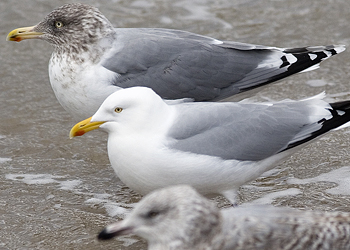 |
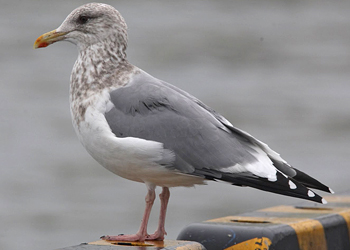 |
Herring Gull (argentatus) adult, February 07 2013, Katwijk, the Netherlands (Mars Muusse). Dark argentatus from Scandinavia, and adult argenteus (argentatus and vegae about equal in grey tone). P10: Mirror merges with tip, P9 with large mirror, no black spot on P5. |
Vega Gull (vegae) adult, December 2009 - January 2010, Choshi, Japan (Chris Gibbins). Dark iris, heavily streaked head continuing on upper breast, dark grey upperparts. Vegae has much black in wingtip. |
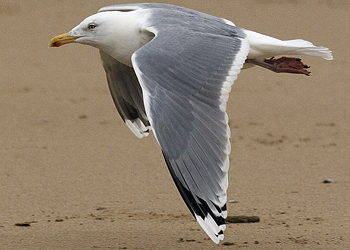 |
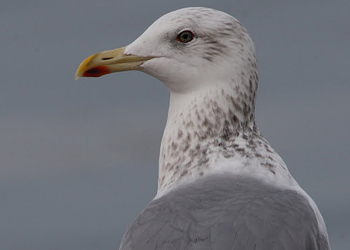 |
Herring Gull (argentatus) adult, February 14 2012, Noordwijk, the Netherlands (Mars Muusse). Thayeri pattern on P9 and P10, broken band on P7 and only faint black spots on P6. Probably from N Scandinavia. About Kodak 6-7 grey tone. |
Vega Gull (vegae) adult, December 2009 - January 2010, Choshi, Japan (Chris Gibbins). Dark iris, dark grey upperparts (Kodak 7-8). |
 |
 |
Herring Gull (argentatus) adult, December 02 2012, Katwijk, the Netherlands (Mars Muusse). In argentatus, northern birds are darker on upperparts, but also show less black in wingtip. Here, no sub-terminal band on P10, mirror on P9 covering both webs, no black spot on P5. Yellow orbital ring. |
Vega Gull (vegae) adult, December 2009 - January 2010, Choshi, Japan (Chris Gibbins). Dark iris, dark grey upperparts (Kodak 7-8), late moult (P8 fully grown, P9-P10 growing), and pink legs. Note purplish orbital ring. |
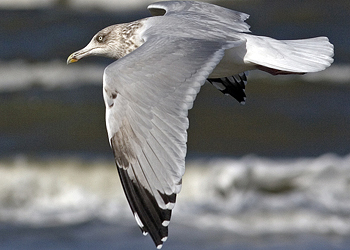 |
 |
Herring Gull 4cy, October 07 2012, Noordwijk, the Netherlands (Mars Muusse). Heavy streaking on head and breastcommon in full adult Vega Gull, in Europe more associated with immature birds. |
Vega Gull vegae adult, December 05 2012, Choshi, Japan (Hiyashi Haka). Late moult, P7/P10. Note deep coral red orbital ring and gape. Very heavy winter streaking, down on breast. Note large white neck patch above mantle. |
 |
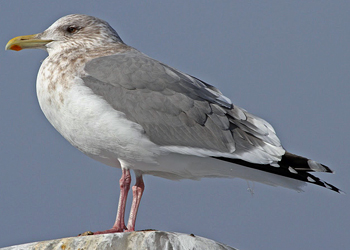 |
Herring Gull (argentatus) adult, December 02 2012, Katwijk, the Netherlands (Mars Muusse). Bird with more black on P9-P10, still no black on P5. Full sub-terminal band on P10, no mirror on P9. Yellow orbital ring. |
Vega Gull (vegae) adult, January 21 2011, Japan (Stuart Price). Dark iris, heavily streaked head continuing on upper breast, dark grey upperparts (Kodak 7-8), much black in wingtip (short tongue on P10 and full subterminal band on P10), broad secondary tips and pink legs. |
 |
 |
| Herring Gull adult, July 18 2013, Noordwijk, the Netherlands Mars Muusse. With immature Lesser Black-backed Gull in background. No black on P5. Black on outerweb of P8 not reaching to primary coverts. No obvious white tongue tips. Kodak 5-6 in continental argenteus. |
Vega Gull vegae adult, July 02 2013, Kamchatka, Russia (Benjamin van Doren. Full sub-terminal band on P5 and P10, with much black on outerweb of P5. Black on outerweb of P4. Black on outerweb of P8, P9 and P10 reach to primary coverts. Red orbital ring, yellow iris. Broad white trailing edge to secondaries. Large 'moons', white tongue tips on P5-P7 with sharp division between grey and white. |
.
ADULT PLUMAGES.
Adult smithsonianus breeding over the complete range of the continent is highly variable. Due to this individual variation, only the most characteristic American birds are acceptable in a European context (and we do not know exactly how large this proportion is). Below is a set of 9 characteristics for adult smithsonianus. It’s good to remember that many birds within the US and Canada have a negative score on at least a few of these points. And it is also good to remember that many argentatus / argenteus from Europe show high scores on this list. As a result, Herring Gulls hatched in Canada, hence pure smithsonianus, may still be unacceptable in a European context, by the simple fact that we can not rule out local birds.
Adult American Herring Gull smithsonianus
- upperparts have to be Kodak 5, which match local argenteus, obviously paler than dark Scandinavian argentatus (which have Kodak 6-7).
- pale tongue tips.
- P10 pattern – pale tongue on innerweb >50% of feather length, ending with a sharp angle; despite the long tongue, there is also a (near) complete black sub-terminal band on P10.
- P9 pattern - small mirror on innerweb only; longue pale tongue; black on outerweb not reaching to primary coverts.
- P8 pattern tongue is >75% of feather length; black bayonet pattern on outerweb.
- P7 pattern - black bayonet pattern on outerweb.
- P6 pattern – W-shaped sub-terminal band.
- P5 pattern – ideally with symmetric W-shaped sub-terminal band.
Additional characteristics
- heavily patterned ‘hooded’ winter streaking.
|
 |
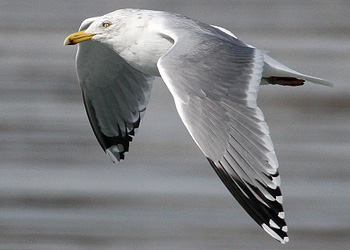 |
| Herring Gull adult, January 23 2013, Katwijk, the Netherlands (Mars Muusse). To find smithsonianus, start with a pale argenteus-grey bird, with deep tongue on P10. It should have sub-terminal bands on P5-P10 and bayonets on P7-P8 (like P8 in this bird). |
American Herring Gull (smithsonianus) adult, February 20 2007, Bluff-Point State Park, CT (Mats Wallin). Classic wingtip pattern to look for in European context: deep tongue on P10, nevertheless subterminal black on P10, small mirror on P9, bayonet on P7, deep W-shape band on P5 and P6. |
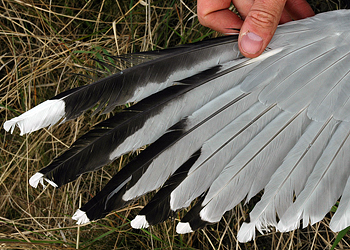 |

|
| Herring Gull (argenteus) female 11CY HL May 04 2006, Moerdijk, the Netherlands (Mars Muusse). If argenteus has a deep tongue on P10, there is no sub-terminal black on P10. No "bayonets" on P7-P8, no drawn-out W shape on P6 and no W shape on P5 are features different from many Newfoundland smithsonianus. |
American Herring Gull (smithsonianus) adult, February 10 2008, Dryden, NY (Mike). Showing classic smithsonianus upperwing, never present in European birds: long pale tongue on P10 ends curved, very steep, leaving a narrow medial band (almost thayeri pattern), yet in combination with full sub-terminal band. No mirror on P9, 'bayonets' on P6-P8, white moons on P7-P8, W-shape on P5. |
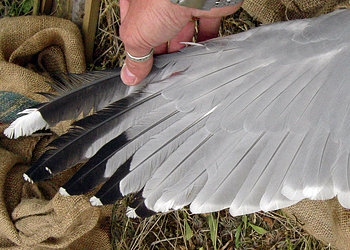 |
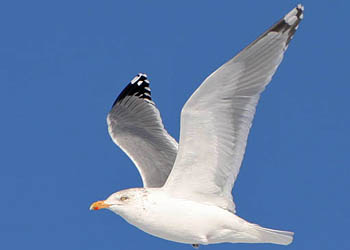 |
Herring Gull (argenteus) male 8CY NE May 16 2006, Moerdijk, the Netherlands (Mars Muusse). Short tongue on P10 and no sub-terminal black on P10. No "bayonets" on P7-P8, but blunt ending black onouterweb. This pattern in the outerwing is very common in continental argenteus,and obviously diffeernt from (acceptable) smithsonianus. |
American Herring Gull (smithsonianus) adult, February 24 2008, Newfoundland (Bruce Mactavish). Full sub-terminal black band on P10. White tongue on P10 innerweb >1/2 length of the visible feather, ends sharply, abrupt, not gradually (oblique). Mirror on P9, and black on P9 does not reach primary coverts. No obvious bayonets on P6-P8. P5 with ill-defined W-pattern. |
 |
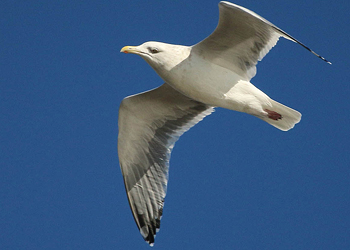 |
Herring Gull adult, February 07 2013, Katwijk, the Netherlands (Mars Muusse). Bird approaching characteristic set for smithsonianus regarding wing-tip. P10: Mirror separated from tip, P9 with small mirror on innerweb and black not reaching primary coverts, P8 grey tongue more than 3/4 of the innerweb, W-shaped black on P5. Also hint of bajonet on P6 but more so on P7. No clue on P10 tongue unfortunately, but of course this bird is way too dark and probably argentatus from Scandinavia. |
American Herring Gull (smithsonianus) adult, December 10 2013, Half Moon Bay, California (Alvaro Jaramillo). Deep pale tongue on underside of P10, in combination with full sub-terminal band. P9 pattern difficult, but probably very small or no mirror. Full band on P5. |
 |
 |
| Herring Gull (argenteus) female 23CY YAJP March 24 2010, IJmuiden, the Netherlands (Mars Muusse). Banded in 1987 in the Netherlands. Female argenteus less bulky than smithsonianus. |
American Herring Gull (smithsonianus) adult, December 26 2007, Rochester (Mike). Typical long pale tongue on P10, yet combined with full sub-terminal band. Note streaked head. |
IMMATURE PLUMAGES.
Immature smithsonianus is highly variable, just as are the European counterpart argentatus and argenteus. Due to this large individual variation, only the most characteristic American birds are acceptable in a European context and quite a few would probably go unnoticed in the large flocks of local Herring Gulls, would they have ended up on this side of the pond. Immature Vega Gull vegae from NE Russia look extremely similar to European birds, and so far there is no diagnostic set of traits to completely eliminate the possibility one is looking at a local European Herring Gull. Nonetheless, a few example birds are presented here as well, together with links to more images on this website.
Below is a set of 10 characteristics for 1W smithsonianus. It’s good to remember that many birds within the US and Canada have a negative score on at least a few of these points. And it is also good to remember that many argentatus / argenteus from Europe show high scores on this list. As a result, Herring Gulls hatched in Canada, hence pure smithsonianus, may still be unacceptable in a European context, by the simple fact that we can not rule out local birds.
First cycle (first winter) American Herring Gull smithsonianus
- undertail coverts and vent with dense barring, ideally reducing the pale parts into pairs of spots, and the longest undertail coverts completely dark on the centres.
- uppertail coverts and rump densely barred, hardly contrasting with other upperparts (hence continuing into pattern of lower back).
- tail feathers ideally completely blackish, including most of the outerweb of R6.
- smooth solid texture on underparts; solid pattern forming one area from chin and hindneck over belly and flank, chevron patterns only starting from last feathers on flank.
Additional characteristics:
- size is large and heavily built', like Glaucous Gull in jizz.
- parallel bill lacking obvious gonydeal angle.
- only narrow notched pattern on upperpart feathers, adding to the overall darkness of the bird.
- tertial pattern close to Lesser Black-backed Gull graellsii, hardly notched.
- centres of outer greater coverts forming dark band.
- only ill-defined pale window on inner primaries.
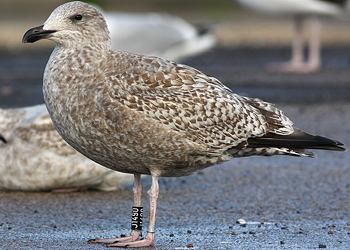 |
 |
Herring Gull (argentatus) 1st cycle J1490 November 27 2011, Boulogne-sur-Mer, France (Jean-Michel Sauvage). Banded in NE Norway (70°N). Most scapulars still juvenile. Argentatus match smithsonianus in jizz and sometimes in underpart texture, still, widely spaced undertail coverts and much proximal white in tail. Also delicate streaking on head and in neck, not blotchy. |
American Herring Gull (smithsonianus) 1st cycle, October 08 2006, Newfoundland (Bruce Mactavish). Juvenile plumage, no scaps replaced by early-Ocober. Scapular tips start to show a first sign of wear and upperpart edgings have bleached to whitish. Note the pale base of the bill, uniform under-parts and neck, dark tail, bold pattern on undertail-coverts. Thin white fringes on primary tips. |
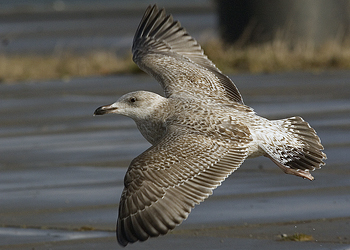
|
 |
Herring Gull (argentatus) 1st cycle C-730184 December 09 2010, IJmuiden, the Netherlands (Mars Muusse). Banded in N Russia (67°N). Upper scapulars 2nd gen, lower scapulars still juvenile. Largely pale rump, uppertail coverts and bases of rectrices, unlike smithsonianus. |
American Herring Gull (smithsonianus) juvenile X50 August 30 2012, Gloucester, MA (Keith Mueller). Juvenile fresh dark plumage, but already single feathers in upper scapulars seem to be missing. Note overall dark brown aspect, bill size and shape, and dull pinkish on bill base. |
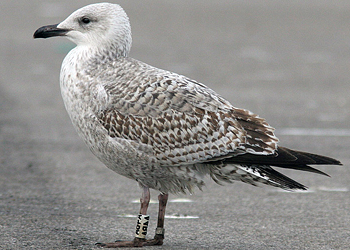 |
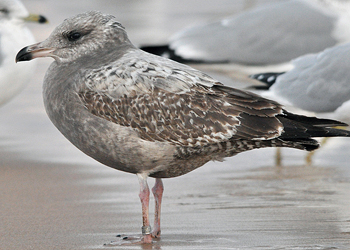 |
Herring Gull (argenteus) 1st cycle A4BA November 24 2006, Boulogne-sur-Mer, France (Mars Muusse). Banded in U.K. All scaps 2nd gen, except rear lower scapulars. Wide spacing on undertail coverts, much proximal white on rectrices, very pale headed. Delicate "pencil" streaking in neck, not blotchy. |
American Herring Gull (smithsonianus) 1st cycle 1106-13848 December 07 2013, New Buffalo, MI (Amar Ayyash). Banded June 2013 at Door County WI (44ºN). All scaps replaced. Much of brown aspect replaced in neck, side of breast and flanck, now cold greyish. |
 |
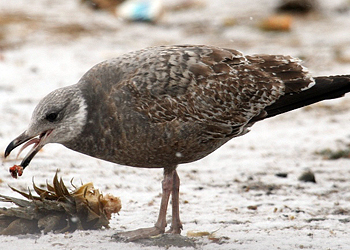 |
Herring Gull (argenteus) 1st cycle XY1T December 03 2012, Boulogne-sur-Mer, France (Jean-Michel Sauvage). Banded in London in winter. All scaps 2nd gen, except rear lower scapulars. Wide spacing on undertail coverts. Pale underparts with delicate streaks. |
American Herring Gull (smithsonianus) 1st cycle, February 09 2008, Dryden, NY (Mike). Brown aspect. Fresh feathers (grey) on hindneck, side of the neck and flank. Crown and ear-coverts replaced as well, throat worn whitish 1st gen feathers. Pale bill base. |
 |
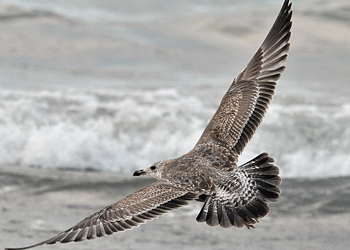 |
Herring Gull 1st cycle, January 23 2013, Katwijk, the Netherlands (Mars Muusse). Pale undertail coverts and head. No smooth, washed out texture on underparts, instead much lining and spotting. |
American Herring Gull (smithsonianus) 1st cycle 1106-27465 December 07 2013, New Buffalo, MI (Amar Ayyash). Banded June 2013 at Door County WI (44ºN). Note paler panel on inner primaries, poor contrast between outer and inner webs on blackish outer primaries, mostly blackish tail and note bill size and shape. |
 |
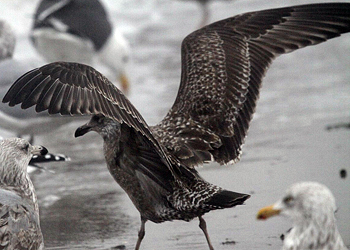 |
| Herring Gull 1st cycle, December 03 2013, Katwijk, the Netherlands (Mars Muusse). Scapulars 2nd gen. Largely pale rump, pale uppertail coverts and pale bases of rectrices. |
American Herring Gull (smithsonianus) 1st cycle, March 02 2013, Circle Beach, CT (Keith Mueller). Some dark pigmented birds have a poor contrasting paler window on the inner primaries. |
 |
 |
| Herring Gull argentatus 1st cycle J1118 September 27 2009. Very smithsonianus-like: heavily barred rump and undertail-coverts, dark tail, plain dark underparts. Ringed as chick in a colony of argentatus Herring Gull at Storøytåa, Mandal, Norway on June 25 2009. Birds like this justify a strict set of criteria. |
American Herring Gull smithsonianus, juvenile, August 25 2010, St. John's, Newfoundland, Canada (Dave Brown). Note pale window on inner primaries, dark base to greater coverts, densely barred rump and undertail and very limited vermiculation along edges of outermost rectrices. |
 |
 |
Herring Gull argentatus 1st cycle J6XN August 09 2006. Blue J6XN shows almost all smithsonianus features to perfection: dark tail, heavily barred rump and undertail-coverts, dark based greater-coverts and tertials, restricted primary window and chocolate brown texture of entire plumage. A minor thing that separates this bird from a perfect smithsonianus is that it appears a bit too streaked on the breast/belly, a feature that would probably go unnoticed in less favourable light...
The ring also poses a problem, of course. This bird was ringed as chick on Storøytåa, Mandal, Norway 23.06.2006. The prescence of birds looking like this, evidently born in a Norwegian population, makes positive identification of smithsonianus in Europe very difficult.
It is of course a possibility that smithsonianus has interbred with argentatus for years in the Storøytåa colony. This could explain the regular occurence of smithsonianus-lookalikes in the area. |
American Herring Gull smithsonianus, juvenile, September 22 2012, Plum Island, Massachusetts, USA (Suzanne Sullivan). Note heavily barred rump and uppertail-coverts, barely contrasting with back; also, note almost entirely dark rectrices with contrastingly pale shaft and narrow 'barred' strip along outermost edge. |
1st cycle Vega Gull vegae
Immature Vega Gull vegae from NE Russia look extremely similar to European birds, and so far there is no diagnostic set of traits, but a few points may be relevant in 1st cycle Vega Gull:
- tertials often obviously darker than brown tone in coverts, only narrow pale fringe lacking deep notching (less contrasting in European Herring Gull);
- uppertail coverts more densely barred (widely spaced chevron pattern in European Herrings):
- rectrices with broader dark band (often narrower dark tail band in European Herrings).
Below are a few example birds, for more birds see HERE.
 |
 |
Herring Gull (argentatus)1st cycle JL6Z February 05 2005, S Norway (Nils Helge Lorenzen). Deep notching on coverts and on tertial fringes.
|
Vega Gull (vegae) 1st cycle, January 31 2010, Choshi, Japan (Gullog). Atypical bird in a European context, with no notching on tertials (and tertials darkest part of bird together with visible primaries like in cachinnans) and very simple pattern on 2nd gen scaps. |
 |
 |
Herring Gull 2cy (argentatus) 1st cycle J0AG February 05 2005, S Norway (Nils Helge Lorenzen). Tertials not obviously darker than brown tone of coverts, rather similar. |
Vega Gull (vegae) 1st cycle, January 31 2010, Choshi, Japan (Gullog). Piano key pattern on GC but hardly any notching on TT. Scap moult: 50-75%. |
 |
 |
Herring Gull 1cy (argenteus) 1st cycle YAMF December 09 2010, IJmuiden, the Netherlands (Mars Muusse). Replaced scapulars for 2nd gen feathers. Head, neck and flanks 2nd gen as well. Coverts and tertials juvenile. |
Vega Gull (vegae) 1st cycle, January 31 2010, Choshi, Japan (Gullog). Very similar to European Herring Gull. Piano key pattern on GC and deep notching on TT. Scap moult: 75-99%. |
 |
 |
| Herring Gull (argentatus) 1st cycle KV48 December 31 2006, Oostende, Belgium (Francois Roland). From Murmansk (67.05 N, 32.29 E). Probably female. |
Vega Gull (vegae) 1st cycle, January 31 2010, Choshi, Japan (Gullog). Pale grey-brown base colour of scaps suggest these feathers were replaced quite recently, and still not bleached. Scap moult: 100%. |
 |
 |
Herring Gull 2cy, January 23 2013, Katwijk, the Netherlands (Mars Muusse). Showing pattern on 1st gen inner primaries. |
Vega Gull (vegae) 1st cycle, January 25 2011, Choshi, Japan (Terry Townshend). Dark secondary bar. Pale panel on inner primaries reaching outer secondaries S1-S3 and still innerweb of P6 largely pale. |
 |
 |
Herring Gull argentatus 1st cycle, December 03 2013, Katwijk, the Netherlands (Mars Muusse). Showing upperwing and tail pattern. No scaps replaced. |
Vega Gull (vegae) 1st cycle, January 27 2011, Choshi, Japan (Terry Townshend). Very similar to European Herring Gull. 1st gen flight feathers. |
In Dutch Birding Vol 26-01 2004 Lonergan & Mullarney address 9 criteria for identification of 2nd cycle (2nd winter) smithsonianus in a flock of European Herring Gull argentatus and argenteus. With growing age, a smaller proportion of smithsonianus remains "acceptable" in a European context (maybe a minority, but not quantified?).
Second cycle (2nd winter) American Herring Gull smithsonianus
- solid brown feathers in neck (brown boa) without any lining, form a sharp division to mantle. From the neck the solid texture continues to side of breast and flank.
- tertials with extensive very dark centres, hardly a pale tip. No transversal lines and hardly any notching.
- undertail coverts and vent with dense barring, ideally reducing the pale parts into pairs of spots, and the longest undertail coverts completely dark on the centres.
- uppertail coverts and rump densely barred in fall. Late winter feathers of rump will be replaced for white feathers.
- tail feathers ideally completely blackish, including most of the outerweb of R6.
- bi-coloured bill like in Glaucous Gull hyperboreus.
- primaries in smithsonianus similar to argentatus, but only seldom with mirror on P10.
- underwing coverts solid brown, lacking any barring.
- uniform greater coverts, limited lining or barring.
- upperparts, A: if brown, then hardly any barring but uniform back, scapulars with dark triangular centre and pale fringe; B: if back is grey, then often contrast between grey back and brown shawl in neck, brown coverts and brown underparts.
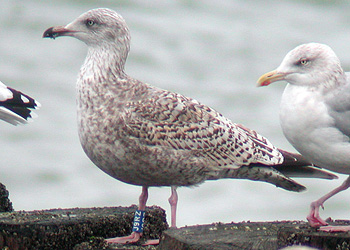 |
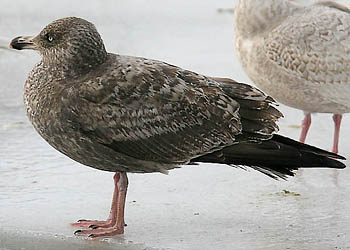 |
| Herring Gull (argentatus) 2nd cycle J9RZ November 01 2007, Westkapelle, the Netherlands (Pim Wolf). Banded in NE Norway (70°N). Resembling 1st cycle, but pale eye and mirror on underside of 2nd gen P10. Much white in tail and pale underparts. |
American Herring Gull (smithsonianus) 2nd cycle, February 07 2005, Newfoundland (Jeff Poklen). Bold 'smoky' winter streaking concentrated in the hindneck, but also on flanks and underparts. Obvious greater covert bar. Note replaced upper tertials and greater covert #2 (from partrial autumn moult), and note pale iris. From a European perspective probably 'the most rewarding' type of bird to look for. |
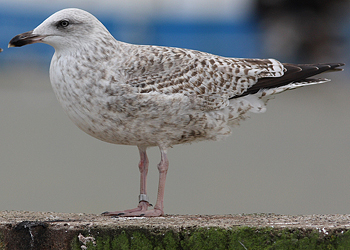 |
 |
| Herring Gull (argenteus) 2nd cycle GR20814 November 28 2012, Boulogne-sur-Mer, France (Jean-Michel Sauvage). Banded in the U.K. Pale eye and chequered tertial centres and greater coverts. Much white in tail, undertail coverts and pale underparts. |
American Herring Gull (smithsonianus) 2nd cycle P02 March 05 2012, NH Coast (Keith Mueller). Banded July 15 2010. Classic 2nd cycle plumage with pale panel on inner primaries, and mostly dark outer primaries. |
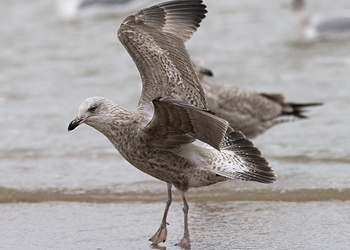 |
 |
Herring Gull (argentatus) 2nd cycle, November 26 2013, Katwijk aan Zee, the Netherlands (Mars Muusse). Complete moult finished. Unringed, hence no provenance on origin but overall coloration and jizz suggest nominate argentatus. Pale rump. |
American Herring Gull (smithsonianus) 2nd cycle, December 08 2012, Lake County, IL (Amar Ayyash). Classic 2nd cycle plumage with pale panel on inner primaries, and mostly dark outer primaries. |
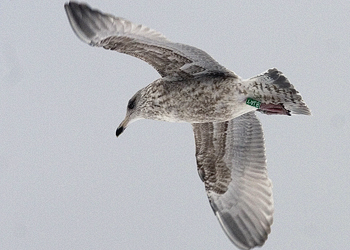 |
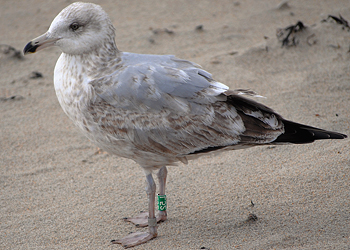 |
Herring Gull (argenteus) 2nd cycle YALB December 23 2010, IJmuiden, the Netherlands (Mars Muusse). Banded as pullus in 2009. Pale iris, pale base of bill and typical checkered pattern of 2nd gen secondaries. Pale undertail coverts with wide spacing, pale base of outer rectrices. Spotted underparts. |
American Herring Gull (smithsonianus) 2nd cycle L52 April 13 2013, Hampton beach, NH (Jon Woolf). Banded in 2011. A relatively "advanced" individual, but note 2nd generation flight feathers (pattern on lower TT and especially dark centres of secondaries just visible beneath GC's). Birds like this are likely to go undetected in Europe. |
Below are 10x Vega Gulls (vegae) in 2nd cycle, all photographed between December 27 2009 - January 04 2010, Choshi, Japan, by Chris Gibbins. They have 2nd gen flight feathers, sometimes with faint mirror on P10. There is often thin vermiculation at the tops of innerwebs of P2-P4, similar to European Herring Gull. They are very pale on rump and proximal half of rectrices, unlike American Herring Gull. Markings on undertail coverts are widely spaced, like in European brds, unlike American Herrings. If any grey tone is present on the fresh feathers, this is a shade darker than on argenteus and on smithsonianus.
Third cycle (3rd winter) American Herring Gull smithsonianus
With climbing age in American Herring Gull, less birds can be identified within flocks of European birds. Only the most eye-catching birds will stand out, showing classic smithsonianus features:
- almost completely dark tail,
- sharp black spots in seconadry centres,
- dense brown texture in hindneck running down on side of breast and underparts,
-
outer primary pattern start to look like adults, with deep tongue on P9, bayonets on P7-P8 and W-shape on P5.
 |
 |
Herring Gull (argentatus) 3rd cycle, January 30 2010, Westkapelle, the Netherlands (Pim Wolf). Solid brown neck, much black in tail reminds of smithsonianus, but from Scandinavia and of course bird is way too dark for smithsonianus. |
American Herring Gull (smithsonianus) 3rd cycle, February 09 2008, Dryden, NY (Mike). 2nd cycle and 3rd cycle birds best aged on inner primaries pattern. However, this is an easy bird to age, with very immature upperparts, combined with typical 3rd gen primaries: black with small but obvious white tips and an obvious mirror on P10. |
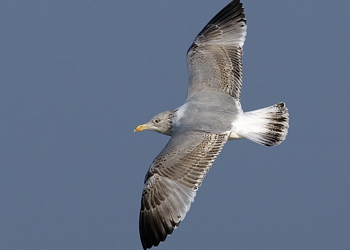 |
 |
Herring Gull 3rd cycle, January 23 2013, Katwijk, the Netherlands (Mars Muusse). 3rd and 4th cycles difficult to separate in many cases, but a single small mirror on P10, much dark in secondaries & tail, and extensive brown coverts is generally associated with 3rd cycle birds. All secondaries and rectrices patterned, but no sharp defined black ink-spots as in smithsonianus; instead often with vermiculation and paler, brownish, not blackish. |
American Herring Gull (smithsonianus) 3rd cycle, January 04 2012, Whiting, IN (Amar Ayyash). Aged on inner primary pattern and adult type central tertials replaced in partial autumn moult. No mirror on P10 (hence outer primaries in resting bird would look like in 2nd cycle. |
 |
 |
| Herring Gull 3rd cycle, March 13 2013, Noordwijk, the Netherlands (Mars Muusse). Third generation flight feathers: inner primaries adult-like, including P5. Outer primaries immature, lacking mirror on P10. When resting, bird may be mis-aged as 3CY. Much black in tail. |
American Herring Gull (smithsonianus) 3rd cycle, April 15 2012, Offshore NY/NJ. (Benjamin van Doren). Adult-like grey inner primaries, central primaries with sharp blackish sub-terminal band and mirror on P10 in combination with many immature markings in coverts and tail. |
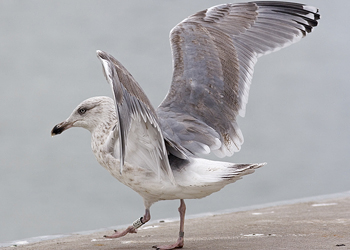 |
 |
Herring Gull (argentatus) 3rd cycle KH89 October 31 2011, IJmuiden, Netherlands (Mars Muusse). Banded as pullus in 2009 in N Russia (70°N). Thayeri pattern on P9. Clean rump and white underparts. |
American Herring Gull (smithsonianus) 3rd cycle, November 09 2013, Clinton Co, IL (Amar Ayyash). Aged by adult-like grey P1-P2 and adult-like pattern on P4-P6, also mirror on P10. Note much black on tail and centres of secondaries. Already deep pale tongue on P8. |
Sub-adult winter American Herring Gull smithsonianus
American Herring Gull in sub-adult plumage can be told apart from European birds by the same wingtip features as in full adults (see above). Sub-adults are immature birds, hence still show some vestiges of immaturity. These dark markings are often found in greater primary coverts, but also on tail or secondary centres. In smithsonianus the markings are deep blackish, very sharply bordered from the grey or white and different from the vermiculated or faded brown markings in European Herring Gulls.
 |
 |
Herring Gull sub-adult, January 23 2013, Katwijk, the Netherlands (Mars Muusse). Almost completely white tail with single black streaks, mirror on P9 and P10, not much black on bill indicate 5CY. Primary pattern completely wrong for smithsonianus: no W-shape on P5 and not on P6, no bayonets on P7 nor P8. |
American Herring Gull (smithsonianus) sub-adult, February 09 2008, Dryden, NY (Mike). Overall much adult-like but with obvious immature central tertials (black ink-spot), some brown feathers in the carpal edge and relatively much black on bill. Note lack of obvious white primary tips. |
 |
 |
Herring Gull sub-adult, January 23 2013, Katwijk, the Netherlands (Mars Muusse). Central primaries echo the adult pattern, showing obvious sub-terminal bands with pale tip on P5. Outer primaries may appear surprisingly immature, brown without white tips. P10 may or may not show a mirror. At least a reasonable set of secondaries appear adult-like, predominantly grery with an obvious white tip. Note complete white tail. |
American Herring Gull (smithsonianus) sub-adult, September 03 2013, Stratford, CT (Donna Rae Henault Caporaso). P6/P9. Dark patterned old rectrices, and white new central feathers. Extensive black on visible secondaries (exposed now the greater coverts have been dropped). |
 |
 |
Herring Gull 4th cycle, November 20 2012, Katwijk, the Netherlands (Mars Muusse). Probably argenteus. Black sub-terminal bands on central primaries with sharp borders. Note ink-spots in tail, but pattern on P5-P8 wrong for smithsonianus. |
American Herring Gull (smithsonianus) sub-adult, February 20 2010, Wisconsin (Chris West). Obvious dark markings in greater primary coverts and some black in tail. Note isolated black spot on one secondary centre. |
 |
 |
Herring Gull sub-adult, December 02 2012, Katwijk, the Netherlands (Mars Muusse).Full sub-terminal band on P10, no mirror on P9, full black band on P5. Note dark smudge on greater primary coverts and outer GC. |
American Herring Gull (smithsonianus) sub-adult, December 02 2012, Milwaukee, WI (Amar Ayyash). Classic bird. Black in tail; other signs of immaturity: bill colour and markings in greater primary coverts. |
 |
 |
Herring Gull sub-adult, March 13 2013, Noordwijk, the Netherlands (Mars Muusse). Note sharp black spots in rectrices. |
American Herring Gull (smithsonianus) near-adult, February 24 2008, Newfoundland (Bruce Mactavish). Note vestiges of black on centre of primary coverts and in the rectrices, an indication of younger adult. Sub-terminal black band on P10 broken at the shaft. Small mirror on P9 confined to inner-web. P8-P7 with black "bayonet" along outer edge, but 'bayonet-step' in black not obvious. P5 band broken at the centre, lacking drawn-out characteristic black W-pattern. |
Distribution of American Herring Gull smithsonianus
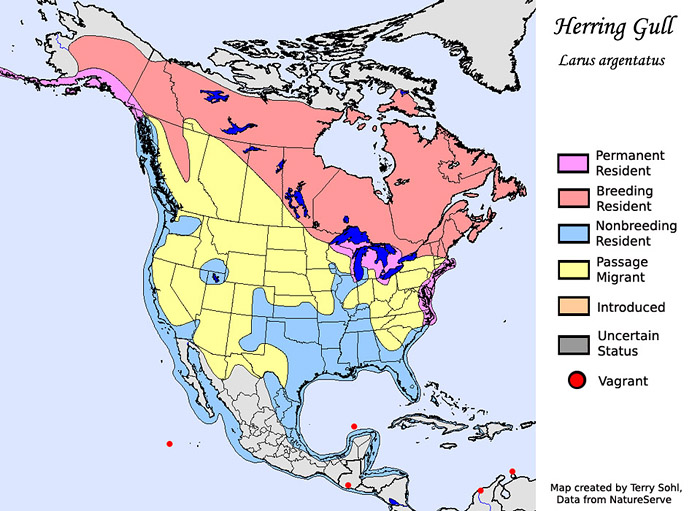
Group 1
Common Gull - Mew Gull - Ring-billed Gull
Group 2
Thayer’s Gull -
Kumlien’s Gull - Iceland Gull
Group 3
Great Black-backed Gull - Kelp Gull - Slaty-backed Gull
Group 4
Glaucous-winged Gull - Glaucous Gull
Group 5
Herring Gull - American Herring Gull - Vega Gull |
rings argenteus: U.K.
|
 Herring Gull- Zilvermeeuw (argentatus & argenteus)
Herring Gull- Zilvermeeuw (argentatus & argenteus)




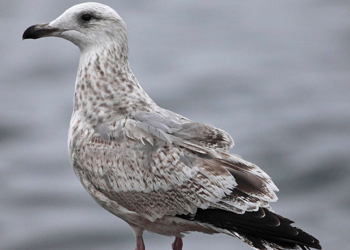
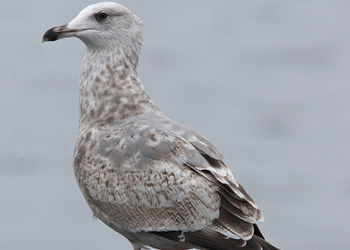
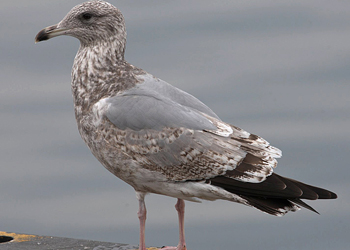
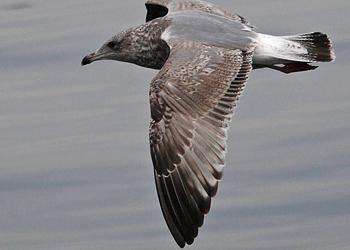

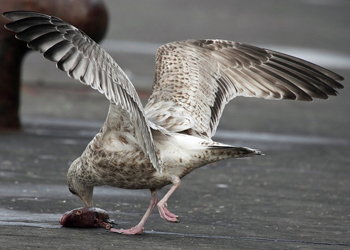
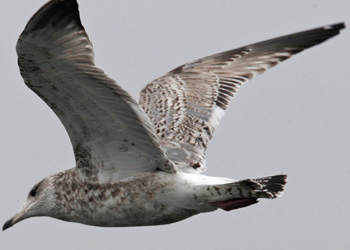

 Herring
Gull A7JG 3cy (argenteus), 2011 & March-July 2012, Boulogne/Mer, France (50.42N,1.34E). Picture: J-M Sauvage.
Herring
Gull A7JG 3cy (argenteus), 2011 & March-July 2012, Boulogne/Mer, France (50.42N,1.34E). Picture: J-M Sauvage. Herring
Gull KCU 3cy (argenteus), May 23 2002, Vuurtorenvlakte -
Maasvlakte, the Netherlands (51.59N,04.02E).
Herring
Gull KCU 3cy (argenteus), May 23 2002, Vuurtorenvlakte -
Maasvlakte, the Netherlands (51.59N,04.02E). Herring
Gull 10 3cy (argenteus), May 31 2009, Vlissingen, Netherlands. Picture: M v Kleinwee.
Herring
Gull 10 3cy (argenteus), May 31 2009, Vlissingen, Netherlands. Picture: M v Kleinwee. Herring Gull 9L 2CY-3CY, November 2016 & May 2017, Katwijk, the Netherlands.
Herring Gull 9L 2CY-3CY, November 2016 & May 2017, Katwijk, the Netherlands. Herring Gull (argenteus) K.C 1CY & 3CY, July 2013 & May 2015, Katwijk, the Netherlands.
Herring Gull (argenteus) K.C 1CY & 3CY, July 2013 & May 2015, Katwijk, the Netherlands. Herring Gull (argenteus) K.BPV 3CY, May 02 2017, Hoornderslag - Texel, the Netherlands.
Herring Gull (argenteus) K.BPV 3CY, May 02 2017, Hoornderslag - Texel, the Netherlands.  Herring Gull (argenteus) Y.CLA 1CY-3CY, October 2017, April - October 2018, May - August 2019, IJmuiden & Katwijk, the Netherlands.
Herring Gull (argenteus) Y.CLA 1CY-3CY, October 2017, April - October 2018, May - August 2019, IJmuiden & Katwijk, the Netherlands.  Herring
Gull 5.412.501 3cy (argenteus), May 11 2004,
IJmuiden, the Netherlands (52.27N
04.33E).
Herring
Gull 5.412.501 3cy (argenteus), May 11 2004,
IJmuiden, the Netherlands (52.27N
04.33E).  Herring
Gull HT-193833 3cy (argentatus),
May 18 2004, Amsterdam, the Netherlands (52.21N - 04.52E). Picture
Ruud Altenburg.
Herring
Gull HT-193833 3cy (argentatus),
May 18 2004, Amsterdam, the Netherlands (52.21N - 04.52E). Picture
Ruud Altenburg. Herring Gull argentatus VA00 3CY, May 18 2003, Tampere dump, Finland. Picture: Visa Rauste.
Herring Gull argentatus VA00 3CY, May 18 2003, Tampere dump, Finland. Picture: Visa Rauste. Herring Gull argentatus J6078 3CY, May 08 2015, Vest-Agder, Norway. Picture: Nils Helge Lorentzen.
Herring Gull argentatus J6078 3CY, May 08 2015, Vest-Agder, Norway. Picture: Nils Helge Lorentzen.  Herring Gull argentatus J6607 3CY, May 08 2015, Vest-Agder, Norway. Picture: Nils Helge Lorentzen.
Herring Gull argentatus J6607 3CY, May 08 2015, Vest-Agder, Norway. Picture: Nils Helge Lorentzen. Herring Gull argentatus J6654 3CY, May 10 2015, Vest-Agder, Norway. Picture: Nils Helge Lorentzen.
Herring Gull argentatus J6654 3CY, May 10 2015, Vest-Agder, Norway. Picture: Nils Helge Lorentzen. Herring Gull argentatus J7001 3CY, May 08 2015, Vest-Agder, Norway. Picture: Nils Helge Lorentzen.
Herring Gull argentatus J7001 3CY, May 08 2015, Vest-Agder, Norway. Picture: Nils Helge Lorentzen. Herring Gull argentatus J7053 3CY, May 09 2015, Vest-Agder, Norway. Picture: Nils Helge Lorentzen.
Herring Gull argentatus J7053 3CY, May 09 2015, Vest-Agder, Norway. Picture: Nils Helge Lorentzen. Herring Gull argentatus J7090 3CY, May 08 2015, Vest-Agder, Norway. Picture: Nils Helge Lorentzen.
Herring Gull argentatus J7090 3CY, May 08 2015, Vest-Agder, Norway. Picture: Nils Helge Lorentzen. Herring Gull (argentatus) JN732 3CY, May 14 2013, Sandøya, Norway. Picture: Ingar Støyle Bringsvor.
Herring Gull (argentatus) JN732 3CY, May 14 2013, Sandøya, Norway. Picture: Ingar Støyle Bringsvor. Herring Gull (argenteus) 3CY, May 27 2015, IJmuiden, the
Netherlands (52.27N-04.33E).
Herring Gull (argenteus) 3CY, May 27 2015, IJmuiden, the
Netherlands (52.27N-04.33E). Herring Gull (argenteus) 3CY, May 27 2015, IJmuiden, the
Netherlands (52.27N-04.33E).
Herring Gull (argenteus) 3CY, May 27 2015, IJmuiden, the
Netherlands (52.27N-04.33E). Herring Gull (argenteus) 3CY, May 27 2015, IJmuiden, the
Netherlands (52.27N-04.33E).
Herring Gull (argenteus) 3CY, May 27 2015, IJmuiden, the
Netherlands (52.27N-04.33E). Herring Gull 3CY, May 22 2014, Katwijk, the Netherlands.
Herring Gull 3CY, May 22 2014, Katwijk, the Netherlands.  Herring Gull 3CY, May 13 2014, Katwijk, the Netherlands.
Herring Gull 3CY, May 13 2014, Katwijk, the Netherlands.  Herring Gull 3CY, May 22 2014, Katwijk, the Netherlands.
Herring Gull 3CY, May 22 2014, Katwijk, the Netherlands.  Herring Gull 3CY/4CY, May 22 2014, Katwijk, the Netherlands.
Herring Gull 3CY/4CY, May 22 2014, Katwijk, the Netherlands.  Herring Gull 3CY, May 22 2014, Katwijk, the Netherlands.
Herring Gull 3CY, May 22 2014, Katwijk, the Netherlands.  Herring Gull 3CY, May 22 2014, Katwijk, the Netherlands.
Herring Gull 3CY, May 22 2014, Katwijk, the Netherlands.  Herring Gull 3CY, May 22 2014, Katwijk, the Netherlands.
Herring Gull 3CY, May 22 2014, Katwijk, the Netherlands.  Herring
Gull 3cy (argenteus), May 17 2002,
Boulogne/Mer, France (50.42N,1.34E)
Herring
Gull 3cy (argenteus), May 17 2002,
Boulogne/Mer, France (50.42N,1.34E) Herring
Gull (argentatus), May 23 2002, Vuurtorenvlakte -
Maasvlakte, the Netherlands (51.59N,04.02E).
Herring
Gull (argentatus), May 23 2002, Vuurtorenvlakte -
Maasvlakte, the Netherlands (51.59N,04.02E). Herring
Gull 3cy (argentatus?), May 16 2002,
Boulogne/Mer, France (50.42N,1.34E).
Herring
Gull 3cy (argentatus?), May 16 2002,
Boulogne/Mer, France (50.42N,1.34E). Herring
Gull 3cy, May 17 2002, Boulogne/Mer, France (50.42N,1.34E).
Herring
Gull 3cy, May 17 2002, Boulogne/Mer, France (50.42N,1.34E).










































































